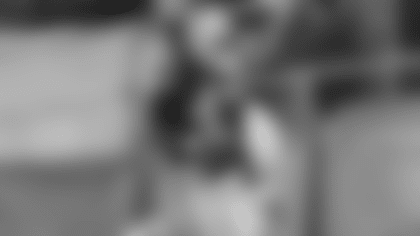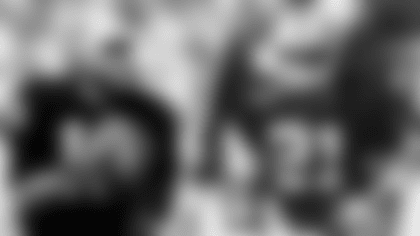By Jim Seimas | Santa Cruz Sentinel

Six decades ago this summer a group of misfits from all parts of the country assembled in town, a vacation destination in Northern California, in an attempt to achieve football glory.
Some players were All-Americans who went unselected in the inaugural American Football League draft earlier that year. Others didn't stick in the heralded National Football League. Some were local standouts attempting to shock the nation by shining during tryouts in their proverbial backyard. And some were overcoming injury, looking for a second shot to continue their dream of again stepping foot on the field.
These prospective professionals gathered at, of all places, Santa Cruz High.
"We had a lot of guys out there," said Pro Football Hall of Fame lineman Jim Otto, now 82. "… it was, to a certain degree, a rag-tag bunch. But we had some pretty good guys. We all helped put that team together and were kicking butt."
They stayed in a historic, but now-defunct, middle-rate hotel off Pacific Avenue. It was a hop, skip and jump away from Memorial Field, their practice facility, which was dotted by gopher holes and ruts. The players often practiced twice a day on subpar facilities. And if they were lucky and talented enough, they'd last the duration of the six-week training camp — and they'd officially become Oakland Raiders.
"Santa Cruz, 1960. That was a long time ago. I'm pretty sure the statute of limitations has expired, so I can talk to you," said 83-year-old Tom Flores, a standout quarterback at Sanger High and College of the Pacific in Stockton. He became the Raiders' first starting signal-caller and, decades later, their Super Bowl-winning head coach.
That's right, today's Raiders, beloved by many and hated by many more, got their start in this surfing community and did so with minimal fanfare.
The Santa Cruz Sentinel reported on June 26, 1960 the Raiders would hold training camp in town. But the front page of the paper was dominated by coverage of Miss San Diego Suzanne Reamo claiming the title of Miss California at the Civic Auditorium. News of the White House administration being accused of blunders in the handling of the U2 spy plane incident and Santa Cruz's dog ordinance controversy also made the cover.
The Raiders were buried in the middle of the paper, on page 14.

Santa Cruz was as much an unknown to the players as they were to its residents.
"I was a young guy, fresh out of college," said Otto, a center who hailed from Wisconsin and shined at University of Miami. "Where is Santa Cruz? That's the first thing you think."
Said Flores: "I don't remember many fans. Nobody knew who we were, nor did we care. We'd tell them, 'Do you know where Oakland is? … OK, do you know where San Francisco is? Well, we're right across the bridge.'"
Behind the scenes
Santa Cruz Chamber of Commerce's sports committee, under the direction of Eli Bariteau, wooed the Raiders to town.
Raiders head coach Eddie Erdelatz, a former Saint Mary's end who coached Navy from 1950-'58, felt Santa Cruz's moderate coastal climate would be most conducive to maximize conditioning. That belief helped Santa Cruz win the bid over Santa Rosa, Moraga, and Calistoga as training camp options.
Flores, having undergone shoulder surgery following failed attempts in the NFL and CFL, was preparing to attend graduate school at Pacific when he got the call to try out. He turned down a teaching job to take part in this historic opportunity. He showed up to the team residence at Hotel Palomar — the area's first building taller than three stories — and found himself in a sea of mostly unfamiliar faces.
"Some were just out of college, some were out of the NFL and some were out of Canada," Flores said. "There were football players of all ages. The love of football, we all had that in common."
On July 11, the Raiders showed up to Santa Cruz for their first practice. Media Day.
Eighty-six players signed contracts and showed up for camp. Erdelatz and his staff had to make a series of cuts, which included getting to 43 players by Aug. 23 and down to 33 by Sept. 6 — five days ahead of the team's season opener.
Santa Cruz High wasn't the perfect venue for camp, but it was hard to beat the weather and the scenery.
Now the Las Vegas Raiders, the team is preparing to play its inaugural season in Sin City.
Flores and his wife, Barbara, visited the Raiders' new $75 million training facility in Henderson, Nevada, last month. It wasn't a high school field pocked with gopher holes.
"Oh man, their workout facility is friggin' breathtaking," he said.

Judging the talent
The roster was reduced to 69 players after three days of practice, Sentinel sports editor Mel Bowen reported. Fourteen were cut and three left camp. Six others were injured, including Santa Cruz's Fred Fehn, a 256-pound tackle who pulled a leg muscle on the first running exercise of camp. Among the more humorous of injuries: Charlie Powell, an ex-49er and ex-pro boxer, pulled a tendon posing for photographers on Day 1.
"If this keeps up, we'll be eating out of a phone booth," Erdelatz told Bowen two days after camp started.
He added: "We've got a good group. There's been no bed check and I haven't even seen one of them smoking."
Erdelatz was big on cardio and drills, not on full-contact scrimmages for much of the first month. He wanted to make sure the players knew the plays.
The cream started to rise to the top.
Flores stood out with his consistent play to emerge from the pack — a very large pack.
"We had eleven quarterbacks the first day of camp," Flores said. "You couldn't get them all in the same picture."
A photo published in the Sentinel on July 12 shows eight quarterbacks crammed into the frame.
Erdelatz held his first scrimmage 11 days after camp started, with the roster already trimmed to 53 players.
Only three quarterbacks were left at camp by the end of July: Flores, 1959 Green Bay Packers draft pick Robert Webb of St. Ambrose College, and Paul Larson, a former All-American out of Cal.
Salinas High alum Tony Teresa, an ex-Hartnell Junior College and San Jose State quarterback who played for the BC Lions of the CFL in 1956-57, was moved to running back. He continued to shine at his new position and made it his to lose a week ahead of the Raiders' preseason opener against the Hank Stram-coached Dallas Texans at Kezar Stadium.
While the Raiders faced deadlines to reduce their roster, they also offered tryouts to players who were being waived by other pro teams.
Teresa went on to lead the team in rushing in 1960, his only year in the league.
The Raiders' spotty defense was led by former San Jose State linebacker Tom Louderback and 33-year-old cornerback Eddie Macon, who finished with nine interceptions.
Little did they know, but two players were at the outset of long storied careers with the franchise: Flores and Otto.

Around town
For whatever the reason, Flores said Erdelatz didn't believe in long practices. The team held two-a-days for much of camp, but there was still plenty of time to enjoy the area.
Flores said he made $50 per preseason game. "Thirty-seven dollars cleared," he said after taking advantage of a local check-cashing outfit. He was paid $350 per game in the regular season.
"We had no money, so we hung around the hotel or the Boardwalk," Flores said. "We'd look at the pretty girls on the beach, which is what most guys do with no money in their pocket."
Flores said the players had a curfew, but Erdelatz and his assistants never performed bed checks. That left an opportunity to sneak out at night, but players had to be willing to pay the price if they were caught — their job.
"Rules were still rules," Flores said. "He gave you a lot of leeway, so it was up to you."
Otto wasn't interested in putting his dream in jeopardy by going out drinking. Well, not hard stuff anyway.
"No alcohol, just beer," Otto said. (And that makes sense if you consider he hails from Wausau, Wisconsin.) "We had to be careful where we were. I didn't want to be the first one accused of having a soda."
For Otto, there was another repercussion if he lost his job, which paid him $8,000 for the season, plus a $1,000 bonus.
"'If you don't drink, you're not going to get in trouble,'" said Otto, quoting advice from his 140-pound father, Lorenz, "'If you get in trouble, I'm going to kick your (butt).'"
Otto said he respected his father too much to test the water. Plus, he wanted to become a professional football player more than anything.
"I wanted to do it in the worst way," he said. "So I didn't go out and do what a lot of the others did."
Otto did have one late night tradition: He bought a large sandwich from a nearby vendor. He wanted to make sure he didn't lose weight after all of the physically demanding practices.
Residents from Otto's hometown wanted him to make the pros, too. But they wanted him on the hometown Packers.
He said he told them, "If I'm going to play for the Packers, I gotta play some place first. So leave me alone to kick some butt."
Temptation was in the players' faces. The Laurel Inn, a watering hole, was located on Laurel Street across from Santa Cruz's football field.
"That's where the players spent most of their evenings," said Tex Ronning, 84, Santa Cruz's lightweight — roughly the equivalent of JV — football coach at the time.
Ronning said he never went in to verify. He heard it from others. "They were the talk of the town," he said of the Raiders. "And it was a popular place for everyone."
Stan Pillsbury, a three-sport athlete who graduated from Santa Cruz in '63 and lived a block away from Laurel Inn, said a large contingent of employees were bussed up to Davenport Cement Plant each day for work. They ended each shift at the Inn.
"It was a pretty tough place," Pillsbury said.
The Raiders had a news hole reserved for them in the Santa Cruz Sentinel sports section every day during camp, but they weren't the only circus in town.
They were temporarily moved to the girls athletic field on campus — a few hundred feet closer to the Laurel Inn — when the Polack Brothers Circus set up shop at Memorial Field in late July.
"The circus came in on the train at 3-4-5 a.m.," said Angelo Ross, 80, a '58 Santa Cruz alum and longtime assistant football coach in the area. "My parents would take us out to watch them unload the animals."
A photographer wanted to set up a photo with a player and tiger, but Erdelatz, fearing for his player's safety, shot down the suggestion.
"You should use some of the guys we sent home for that," Erdelatz told the Sentinel.
Several testosterone-driven players joked about wanting a one-on-one wrestling match with a tiger.
What the photographer did get was Louderback and ex-University of Richmond defensive end Carmen Cavalli playfully trying to tackle an elephant named Opel on a staged fumble.
There was always something to do in Santa Cruz.
On Aug. 1, a day after the Raiders returned from their 20-13 exhibition loss to Dallas in front of 12,000 fans at Kezar, more than a dozen players went deep-sea fishing and caught more than 400 pounds of rockfish. Webb, a backup quarterback, caught three yellowtail cod on one line.
The Raiders stole headline after headline on the Sentinel's sports page, always buried mid-paper though.
"You had a professional team practicing down the street," Ross said. "It was fun. It was entertainment."
Remember when
Pillsbury was one of the lucky few to witness practice regularly. Nearly all of the practices were closed to the public. Still, a handful of curious fans slipped into the bleachers attached to Turner Gymnasium each day. Others peeked through holes in the fence off Myrtle Street.
A high school sophomore at the time, Pillsbury was on the field so often he called himself an unofficial ball boy. The team gifted him a football, bearing the imprinted name of AFL commissioner Joe Foss, but it was later destroyed in a flag football game.
"The NFL was all new to me," Pillsbury said. "I wanted to see the size of the guys, the contact thing. We didn't have Pop Warner back then or Cabrillo College. Compared to high school it was different."
The players weren't huge — not by today's standards — but they played hard, fast and with power.
"They were pretty good," Pillsbury said.
And intense.
"They had a lot of scuffles at practice that had to be separated," Ross recalled. "They kept having new people come to the facility. I attribute their success to Flores, the quarterback. He was a steady guy. Not great, steady."
When the team left town after six weeks, the locker room was a sea of discarded Raiders' gear.
"I got a nice pair of shoes out of the deal," Pillsbury said of his new size 9 cleats.
The Raiders finished their inaugural season with a 6-8 record. They were outscored 388-319. Defense was their weakness — they lost by 14 or more points in seven of their losses.
"We competed because we were in great condition," Flores said. "We'd outrun teams in the fourth quarter."
There are a handful of players and fans who remember the first time the Raiders came to town. (The team returned to Santa Cruz in '61 and '62 before moving their training camp to Santa Rosa.)
"I'd guess that there's probably 10 of us still alive," Flores said of his '60 teammates.
Up until four years ago, Otto returned to Santa Cruz to cut down Christmas trees and gift them to the less fortunate.
He has endured 74 surgeries for his football injuries, including the amputation of his right leg a year ago. His left leg is weakened, leaving him to use a wheelchair. And he has no regrets.
"I worked hard and I won my opportunity to play football," said Otto, a 14-year center for the Raiders who was selected to the Pro Football Hall of Fame in his first year of eligibility in 1980. "I'm so grateful I had the opportunity."
Flores is equally grateful. Perhaps, a Hall of Fame berth awaits him someday. He coached the Raiders to wins in Super Bowl XV and XVIII. Either way, it all started in Santa Cruz.
"I'll always have a soft spot in my heart for Santa Cruz," he said. "That's where the egg was planted."

























